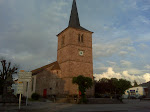We learned from Aunt Cindy that the Littles were Reivers. According the website for the North American branch of Clan Little, "The Scottish border Clan LITTLE was named in an act of the Scottish Parliament of 1587 as one of only 51 truly independent clans in all Scotland, 17 of which were clans of the English-Scottish border. A Clan is a tribe with a strong tie of family blood. In the Anglo-Scottish border wars of 1296 - 1603 the LITTLES were one of the fighting clans living close to the border on the Scottish side. They were constantly raiding or reiving on both sides of the border (reivers are thieves and ruffians, a group of lawless independents). They were horsemen and held in contempt all who went on foot, and by the close of the 16th century they had earned a reputation as the finest light cavalry in Europe . The borders clansmen were an ever ready source of fighting men, a permanent mobile task force when war broke out.
"Many clansmen with less warlike dispositions found their vocation as monks in various abbeys such as Sweetheart, Holyrood and the Franciscan convent of Greyfriars in Dumfries, scene of the murderous episode which launched Robert Bruce of Annadale on the road to the throne.
"The LITTLES for over three centuries shared with the Armstrongs and Beatties the steep-sided dales (valleys) immediately to the North and West of the present town of Langholm [which is where Archibald and Barbara's house was, and where they are buried] at the extreme east of Dumfriesshire (county). Each successive Chief resided on an estate at the foot of the side valley half-way up Ewesdale which is beside the present day road A7, near the stretch from Langholm to Hawick. [We stayed in Hawick, pronounced "hoik", and Jimmy Little was a police constable there in the 1850's.]
"Edward Littil founder of Clan Little (and there have been over 25 spellings of the surname) was active in 1296/7 in South-West Scotland as a guerrilla fighter with Sir William Wallace, the great Scottish patriot who led the first phase of the wars of independence against the oppressive occupation of Scotland by Edward I of England . Many of those who supported Wallace most closely were kinsmen, not the least of whom was “Eduuard Litill” his nephew.
"Simon Little was chief of the Little clan at the ending of the border wars; his son Thomas succeeded him, to be followed by David Little, last Laird of Meikledale, who in 1672 was the last chief to be officially recognized. Since David's time, the Littles have been one of Scotland 's many “heidless” clans (headless - without a chief).
"The clans began to scatter in the 17th century. Littles and Lytles, with neighboring Beatties, Thomsons, Elliots, Armstrongs and Irvings fled from persecution and overcrowding to the Ulster plantations. (Plantations were communities established in North Ireland by England ) Many moved later into neighboring English Cumberland where today, as in Ulster , there are twice as many Littles as in their home country of Dumfriesshire. Many crossed the oceans to North America , Australia , New Zealand , proud of their origins but, over the generations, losing contact with the descendants with those who stayed behind.
"Many of the Littles, Lytles and Lyttles in Ulster re-emigrated as Scots-Irish back to Great Britain or, like hundreds of Littles from the border, headed overseas. The most numerous are in the United States . There are now over 45,000 Little families in the English speaking world, some of English and some of Huguenot origin but most (and especially those in and from Scotland , Ulster and England 's northernmost counties) with deep roots in the old West March of the Scottish border."
We haven't established a direct link from our Archibald to William Wallace YET, but we are hopeful!
In Hawick, a statue (pictured below) shows a Reiver claiming victory for the town. The other photos show two descendents of the Reivers along with our personal family historian Cindy (excluded from the following comment)--ample evidence that the apples don't fall too far from the trees...
(Actually there were family members of the Littles who were not actively raiding and pillaging, and we'd like to believe our ancestors fell into that group...)




No comments:
Post a Comment